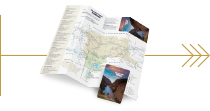Notes From the Road: Finally, Fly Fishing.
I know. You all want me to tell you that the best fly fishing is in the summer, because that’s when the weather is wonderful and the water feels fantastic for wading. Which, I guess, could be the definition of great fly fishing.But if you’re looking for guaranteed bites and a relatively solitary fishing experience, it’s time to dust off your rods now and let your line out, because as the weather starts heating up, the fish start biting.
The Weather
Or rather, the change in the weather. The water is warming up into the 40s and, as it gets a bit more balmy, the fish get a bit more active. In fact, their optimal spawning temperature is 47F. So get out your thermometers and strap on your waders, ladies and gentlemen, fly fishing is about to get a whole lot more fun.
The Appetites
Fish experience a state of torpor, or dormancy, in the winter months, which means that when the weather starts getting warmer, they start getting more active (see above). What this emergence from dormancy means is they haven’t eaten heartily in about six months, so now, they’re looking for some good eatin’.
Sidenote: call my crazy (or a not-so-recently-transplanted-east-coaster) but I didn’t realize fish actually ate flies (I know, I know). I come from a long line of bass fishermen and those fresh water smallmouths ate worms, not flies. So, imagine my surprise when I learned that the fish in the rivers and streams in Montana’s Yellowstone Country were actually accustomed to eating flies that live in the bushes that line the streams and hang out on the water’s surface to lay their eggs.
The Water
The area’s rivers are not yet at their highest flow of the year, which means the water is still relatively slow moving and the current hasn’t kicked up enough mud and dirt to cloud your (or the fishes) view, which is a good thing. In a few weeks (or days, depending on how the weather is warming up), when the snow melts and the rivers are at high flow, you may have better luck drinking and sunning in your drift boat than you’re likely to have catching a trout.
The Crowds
It’s no secret that Yellowstone Country’s most popular tourist season is summer. With the Park just a hop, skip and a jump away, and dry, hot days topped off by cool summer nights, who wouldn’t want to be here in the summer?
As a direct result, our rivers can get busy during the summer months, which can be bad news for anglers. By July, the fish have seen their fill of fisherman just like you trying to sneak around the riverbanks, standing still and pretending you’re just another tree swaying in the wind. In April, however, the fish are coming out of dormancy, still slowed from a winter of lessened activity. They don’t remember fishermen from last season and they’re hungry from a winter with not a lot of food.
The Movement
The fish are getting hungry, the insect larvae are hatching and everything is getting a bit warmer. Fish instinctually recognize these as signs of the approach of spring spawning season, which means they start traveling in groups to their favorite spots on the river to hatch their eggs. We’re not suggesting you go out and throw a line into spawning fish territory (in fact, be sure to check with your favorite shop in Yellowstone Country before you head out, as some stretches of the rivers are closed during spawning season so that females can lay their eggs in peace), but fish are predictable and will start looking for food with greater fervor as the weather warms.
Are you gearing up for fishing season? Would you rather fish during the low flow of summer, but have warm days? Or do you prefer the pre-melt days of early spring that are still just a little bit chilly?


